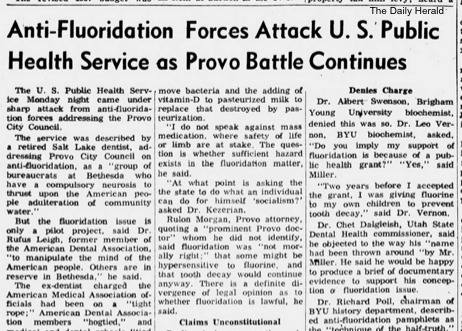Dublin Core
Title
Description
In the early 20th century, trips to the dentist were expensive and painful. Dental hygiene was not as accessible as it is today, and many Utahns suffered from tooth decay. Left untreated, bacteria in the mouth can dissolve tooth enamel and cause excruciating pain, serious infection, and tooth loss. In the late 1930s, chemists discovered that adding small quantities of fluoride to drinking water was an effective tool against tooth decay. By the 1950s, the American Dental Association was promoting low levels of fluoride in drinking water as an effective measure to support widespread dental hygiene. But, public health is often more complicated than mere scientific facts. Utah’s politicians and concerned citizens weighed in, turning the call for fluoridated water into a campaign against the evils of socialism.
Misinformation and fear about fluoridation spread quickly. Despite credible evidence, critics incorrectly associated consuming low levels of fluoride with an increased risk for cancer, heart disease, osteoporosis, and a slew of other health conditions. Fears over fluoride consumption motivated citizens to question the legality and ethics of adding chemicals to the water supply. However, it was the association with socialism that was most effective in thwarting attempts to fluoridate drinking water. Former Utah governor and Salt Lake City mayor, J. Bracken Lee saw fluoridation as a gateway to socialized medical care and feared government overreach.
Opponents to fluoridation questioned the role of government scientists and their apparent readiness to experiment on the American public. Cold War paranoia stoked this anxiety, and groups such as the right-wing John Birch Society threw their weight behind anti-fluoridation activists. The debate over fluoridation raged through the 1960s and 70s, and in 1976, Utah voters approved the “Freedom from Compulsory Fluoridation and Medication Act.” This prohibited the Utah State Board of Health from adding fluoride or other medications to any public water supply.
Water fluoridation is widely considered to be one of the most successful public health measures of the twentieth century. It benefits everyone, but especially those who don't -- or can’t -- seek regular dental care. Despite this, Utah remains one of the least fluoridated states in the nation, with only 52% of the population served by community water fluoridation.
Creator
Source
_______________
See Centers for Disease Control, “Achievements in Public Health, 1900-1999: Fluoridation of Drinking Water to Prevent Dental Caries,” Morbidity and Mortality Weekly Report, October 22, 1999; Centers for Disease Control, “2018 Fluoridation Statistics,” Community Water Fluoridation; Gayle Judd, “Fluoridated Water is Critical for Utahns,” Deseret News, January 11, 2003; Elayne W. Fitzpatrick, “Health Director Asks Water Fluoridation,” Salt Lake Telegram, March 12, 1951; Dr. N. Howell Furman, “Chemistry has Changed Life in the Small Towns of America,” Bingham Bulletin, August 31, 1951; “Citizens Hear Vital Talk on Fluoridation by Dentist,” Vernal Express, November 13, 1952; Pauline Grossman, “ Letter to the Editor,” Times Independent, August 28, 1969; Karl Cates, “Fluoride in Utah? Well, Cold War’s Over,” Deseret News, July 29, 1997; “The Story of Fluoridation,” National Institute of Dental and Craniofacial Surgery, July 2018; “Fluoridated Water,” National Cancer Institute, May 15, 2017; Dennis L. Lythgoe,Let ‘Em Holler - A Political Biography of J. Bracken Lee, Utah State Historical Society (Salt Lake City, UT), 1982; Jesse Hicks, “Pipe Dreams: America’s Fluoride Controversy,” Science History Institute, June 24, 2011.

